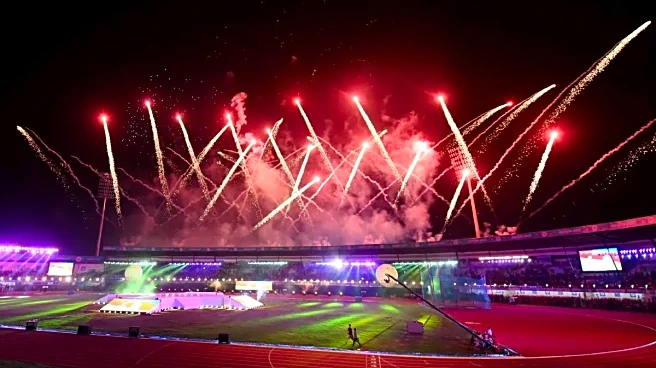What is the story about?
Did you know that estimates suggest that 19,000-20,000 Indians are turning 60 every single day, with the country's elderly population projected to surge from around 150 million today to nearly 350 million by 2050? As India approaches this demographic tipping point, the senior care living sector is preparing for unprecedented growth — and Antara Senior Care, backed by the Max Group, is positioning itself as a frontrunner in shaping what the future of ageing in India will look like.
In an exclusive interaction with CNBC-TV18, Rajit Mehta, MD & CEO of Antara Senior Care, laid out an aggressive five-year expansion strategy driven by shifting social norms, growing financial readiness among seniors, and a stark shortage of structured, medically supervised living environments for older adults.
Mehta said Antara plans to develop nearly 1.5 million sq. ft. of senior-living real estate annually, resulting in 8-10 new communities over the next five years. This expansion is expected to translate into 3,500-4,000 senior-living units during the same period. The company’s footprint, currently concentrated in the NCR, will gradually expand to Noida, Gurgaon and Delhi, with plans to establish a presence in Chandigarh, Bengaluru, Chennai, Hyderabad, Pune and Goa.
This scale-up is being pursued through an asset-light model, with Antara preferring to collaborate with developers who handle the construction, while Antara focuses on its strengths — design, sales and operations. Most of the funding for new developments will be driven by customer collections from project bookings, with Mehta expecting Antara to invest around ₹200 crore in senior-living projects over the next few years, depending on the nature and size of new communities.
Antara currently earns revenue through three streams — design, equity participation and operating income. While each model continues to contribute meaningfully, Mehta believes the operating revenue stream is poised for the strongest leap, with the operations business capable of growing fourfold over the next five years. This optimism is rooted in a simple reality: as seniors age, they require progressively more integrated support systems, and a professionally run, medically supervised operations backbone becomes central to delivering high-quality care.
A fundamental shift under way in India’s social structure is also shaping Antara’s strategy. Mehta observed that families today are displaying a rising preference for “intergenerational living,” wherein seniors live independently but in close proximity to their children and grandchildren. He cited the example of a Bengaluru community where older parents lived in one tower while their children occupied another building within the same gated complex. This pattern, he said, reflects a growing desire for proximity without intrusion — a model that allows seniors to retain autonomy while staying emotionally connected to family.
This trend is emerging as nuclear families rise, young professionals move abroad or work longer hours, and caregiving pressure increases. Mehta believes dedicated senior-living blocks within intergenerational townships address this reality by offering a combination of age-friendly designs, safety infrastructure, social engagement spaces and on-call healthcare — while keeping seniors firmly integrated within a vibrant, multigenerational environment. Antara’s flagship developments like Estate 361 in Gurugram embody this philosophy, and the company expects such formats to become mainstream over the coming decade.
For Mehta, the need for senior-living communities is not merely market-driven — it is “visible, urgent and backed by hard data.” The ASLI–JLL report “Elevating the Golden Years” projects that India’s elderly population will more than double by 2050. Government data shows that nearly three-fourths of Indian seniors live with at least one chronic condition, while close to half face limitations in activities of daily living. Emotional wellbeing is a silent crisis too, with one in three older adults reporting depressive symptoms.
Mehta said that from his own experience caring for his 93-year-old mother, he has seen that seniors require far more than episodic medical treatment; they need predictability, companionship, emotional safety and a sense of purpose. As families become smaller and caregiving becomes more complex, the need for structured senior-living communities with continuous care and supervision has become undeniable. He pointed out that India today has more seniors than Japan, and its “super senior” population — those above 80 — is expected to grow almost threefold, intensifying the demand for medically supervised living and community-led wellbeing ecosystems.
But is India financially ready to invest in such services? Mehta believes it is. Seniors today are more financially empowered, active and decisive about their preferred lifestyles. Retirement mutual fund assets have surged more than 200% since 2020, and private NPS assets, currently at around ₹2.8 lakh crore, are expected to more than triple in the next five years. At the same time, glaring structural gaps persist — only 18% of seniors have health insurance, and nearly 70% depend on others for routine support. Families, both in India and abroad, increasingly want predictable, professionally managed environments for their parents. This demand is evident in Antara’s own performance — its first intergenerational senior-living community in Gurugram was sold out in just 11 months.
Mehta also highlighted a fundamental shift in how seniors perceive wellness. Wellness is no longer confined to physiotherapy sessions or routine check-ups; it has evolved into a comprehensive, continuous approach aimed at delaying decline and enabling seniors to live longer, healthier lives. NITI Aayog data shows that nearly a quarter of seniors struggle with basic daily tasks, while almost half face difficulty managing medication or mobility-related responsibilities. This, Mehta said, underscores the need for integrated wellness platforms that combine modern medicine, functional medicine, physiotherapy, mental health support, Ayurveda, homeopathy, nutrition and lifestyle interventions under one coordinated ecosystem — which is what Antara offers through its Integrated Wellness Centres.
Antara’s biggest advantage, Mehta believes, comes from its parentage. The Max Group’s expertise in healthcare, hospitality and real estate gives Antara a unique positioning at the intersection of all three disciplines. Every staff member — from security personnel to kitchen teams — is geriatric-trained, with all teams proficient in basic life support. Kitchens maintain allergy profiles of residents by default, and operating protocols are built on medically supervised standards. Mehta calls this approach “expert senior care, apno jaisi,” describing it as a blend of professional competence and familial warmth.
The growing seriousness with which India’s real estate ecosystem is viewing senior living also underscores the sector’s maturity. With India expected to have more than 300 million seniors by 2050 and the senior-living sector growing at a compound annual rate of 27%, developers increasingly see the category as one of the most compelling long-term opportunities in real estate. Senior-living units command premiums of 15-20% because they integrate service layers, community design, and healthcare support into the living environment. Over the last 18 months, the sector has seen nearly 20 investment deals, with ticket sizes crossing the ₹100-crore mark. The swift sell-out of Antara’s Estate 361 community in Gurugram has further strengthened confidence that India is not only ready for senior living — it is actively seeking it.
Antara’s expansion now spans independent senior living residences, assisted living, transition care, home-based services, and senior-first consumer products — formats that reflect the diverse ageing journeys of India’s elderly. As seniors move from healthy ageing to preventive wellness, chronic condition management, rehabilitation after hospitalisation or long-term assisted living, Antara aims to provide a continuum of care that eliminates fragmentation and offers families a single trusted platform.
Mehta said the company’s conviction is rooted in demographic reality and day-to-day demand on the ground. “The need is undeniable, the demand is rising, and the value is both emotional and economic,” he said.
As India steps into one of the most significant demographic transitions in its modern history, Antara’s bet on senior living may well position it at the forefront of a sector that is no longer emerging — but accelerating.
In an exclusive interaction with CNBC-TV18, Rajit Mehta, MD & CEO of Antara Senior Care, laid out an aggressive five-year expansion strategy driven by shifting social norms, growing financial readiness among seniors, and a stark shortage of structured, medically supervised living environments for older adults.
Mehta said Antara plans to develop nearly 1.5 million sq. ft. of senior-living real estate annually, resulting in 8-10 new communities over the next five years. This expansion is expected to translate into 3,500-4,000 senior-living units during the same period. The company’s footprint, currently concentrated in the NCR, will gradually expand to Noida, Gurgaon and Delhi, with plans to establish a presence in Chandigarh, Bengaluru, Chennai, Hyderabad, Pune and Goa.
This scale-up is being pursued through an asset-light model, with Antara preferring to collaborate with developers who handle the construction, while Antara focuses on its strengths — design, sales and operations. Most of the funding for new developments will be driven by customer collections from project bookings, with Mehta expecting Antara to invest around ₹200 crore in senior-living projects over the next few years, depending on the nature and size of new communities.
Antara currently earns revenue through three streams — design, equity participation and operating income. While each model continues to contribute meaningfully, Mehta believes the operating revenue stream is poised for the strongest leap, with the operations business capable of growing fourfold over the next five years. This optimism is rooted in a simple reality: as seniors age, they require progressively more integrated support systems, and a professionally run, medically supervised operations backbone becomes central to delivering high-quality care.
A fundamental shift under way in India’s social structure is also shaping Antara’s strategy. Mehta observed that families today are displaying a rising preference for “intergenerational living,” wherein seniors live independently but in close proximity to their children and grandchildren. He cited the example of a Bengaluru community where older parents lived in one tower while their children occupied another building within the same gated complex. This pattern, he said, reflects a growing desire for proximity without intrusion — a model that allows seniors to retain autonomy while staying emotionally connected to family.
This trend is emerging as nuclear families rise, young professionals move abroad or work longer hours, and caregiving pressure increases. Mehta believes dedicated senior-living blocks within intergenerational townships address this reality by offering a combination of age-friendly designs, safety infrastructure, social engagement spaces and on-call healthcare — while keeping seniors firmly integrated within a vibrant, multigenerational environment. Antara’s flagship developments like Estate 361 in Gurugram embody this philosophy, and the company expects such formats to become mainstream over the coming decade.
For Mehta, the need for senior-living communities is not merely market-driven — it is “visible, urgent and backed by hard data.” The ASLI–JLL report “Elevating the Golden Years” projects that India’s elderly population will more than double by 2050. Government data shows that nearly three-fourths of Indian seniors live with at least one chronic condition, while close to half face limitations in activities of daily living. Emotional wellbeing is a silent crisis too, with one in three older adults reporting depressive symptoms.
Mehta said that from his own experience caring for his 93-year-old mother, he has seen that seniors require far more than episodic medical treatment; they need predictability, companionship, emotional safety and a sense of purpose. As families become smaller and caregiving becomes more complex, the need for structured senior-living communities with continuous care and supervision has become undeniable. He pointed out that India today has more seniors than Japan, and its “super senior” population — those above 80 — is expected to grow almost threefold, intensifying the demand for medically supervised living and community-led wellbeing ecosystems.
But is India financially ready to invest in such services? Mehta believes it is. Seniors today are more financially empowered, active and decisive about their preferred lifestyles. Retirement mutual fund assets have surged more than 200% since 2020, and private NPS assets, currently at around ₹2.8 lakh crore, are expected to more than triple in the next five years. At the same time, glaring structural gaps persist — only 18% of seniors have health insurance, and nearly 70% depend on others for routine support. Families, both in India and abroad, increasingly want predictable, professionally managed environments for their parents. This demand is evident in Antara’s own performance — its first intergenerational senior-living community in Gurugram was sold out in just 11 months.
Mehta also highlighted a fundamental shift in how seniors perceive wellness. Wellness is no longer confined to physiotherapy sessions or routine check-ups; it has evolved into a comprehensive, continuous approach aimed at delaying decline and enabling seniors to live longer, healthier lives. NITI Aayog data shows that nearly a quarter of seniors struggle with basic daily tasks, while almost half face difficulty managing medication or mobility-related responsibilities. This, Mehta said, underscores the need for integrated wellness platforms that combine modern medicine, functional medicine, physiotherapy, mental health support, Ayurveda, homeopathy, nutrition and lifestyle interventions under one coordinated ecosystem — which is what Antara offers through its Integrated Wellness Centres.
Antara’s biggest advantage, Mehta believes, comes from its parentage. The Max Group’s expertise in healthcare, hospitality and real estate gives Antara a unique positioning at the intersection of all three disciplines. Every staff member — from security personnel to kitchen teams — is geriatric-trained, with all teams proficient in basic life support. Kitchens maintain allergy profiles of residents by default, and operating protocols are built on medically supervised standards. Mehta calls this approach “expert senior care, apno jaisi,” describing it as a blend of professional competence and familial warmth.
The growing seriousness with which India’s real estate ecosystem is viewing senior living also underscores the sector’s maturity. With India expected to have more than 300 million seniors by 2050 and the senior-living sector growing at a compound annual rate of 27%, developers increasingly see the category as one of the most compelling long-term opportunities in real estate. Senior-living units command premiums of 15-20% because they integrate service layers, community design, and healthcare support into the living environment. Over the last 18 months, the sector has seen nearly 20 investment deals, with ticket sizes crossing the ₹100-crore mark. The swift sell-out of Antara’s Estate 361 community in Gurugram has further strengthened confidence that India is not only ready for senior living — it is actively seeking it.
Antara’s expansion now spans independent senior living residences, assisted living, transition care, home-based services, and senior-first consumer products — formats that reflect the diverse ageing journeys of India’s elderly. As seniors move from healthy ageing to preventive wellness, chronic condition management, rehabilitation after hospitalisation or long-term assisted living, Antara aims to provide a continuum of care that eliminates fragmentation and offers families a single trusted platform.
Mehta said the company’s conviction is rooted in demographic reality and day-to-day demand on the ground. “The need is undeniable, the demand is rising, and the value is both emotional and economic,” he said.
As India steps into one of the most significant demographic transitions in its modern history, Antara’s bet on senior living may well position it at the forefront of a sector that is no longer emerging — but accelerating.
/images/ppid_59c68470-image-176433513371512512.webp)




/images/ppid_59c68470-image-176432503184312941.webp)




/images/ppid_59c68470-image-176423004250176622.webp)
/images/ppid_a911dc6a-image-176421972984347658.webp)



